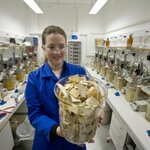Energy

Researchers at the U.S. Department of Energy's Idaho National Laboratory say they have devised an inexpensive way to produce plastic sheets containing billions of nanoantennas that collect heat energy generated by the sun and other sources.
They say this technology is the first step toward a solar energy collector that could be mass-produced on flexible materials.
Traditional solar cells rely on a chemical reaction that only works for up to 20 percent of the visible light they collect. Scientists have developed more complex solar cells with higher efficiency, but these models are too…

Scientists at the University of Sheffield writing in the journal Bioinformatics,say they have shown how bacteria could be used as a future fuel, a milestone in producing truly sustainable fuels in the future.
Like all living creatures, bacteria sustain themselves through their metabolism, a huge sequence of chemical reactions that transform nutrients into energy and waste. With mathematical computer models the Sheffield team have mapped the metabolism of a type of bacteria called Nostoc. Nostoc fixes nitrogen and, in doing so, releases hydrogen that can then potentially be used as fuel.…

Did you know that Norwegian trees require only a few minutes to replace the timber used to produce the first edition of Aftenposten - equivalent to the time we spend making our morning coffee.
Norway is full of forests and the trees are growing. With just one-third of the growth logged, there is plenty of growth each year. In fact, since sheep and other domestic animals no longer graze the scrub, the landscape is actually starting to be overgrown.
Meanwhile, paper production is less and less profitable, hurting the forestry industry. But that won't last, say a group of experts. In fact,…

Accurate measurement of thermal performance is crucial if legislation aimed at producing dramatic reductions in CO2 emissions is to be successful. The UK's National Physical Laboratory (NPL) is offering construction companies a way of meeting this mandate.
Two factors are making the need for accurate measurement of the thermal performance of building products ever more important. Firstly, the Code for Sustainable Homes published by the Department for Communities and Local Government in 2006 set a target of producing zero carbon homes by 2016. The second is the draft Climate Change Bill with…

Livestock manure, left to decompose naturally, emits two particularly potent greenhouse gas emissions (GHGs) – nitrous oxide and methane. According to the Intergovernmental Panel on Climate Change, nitrous oxide warms the atmosphere 310 times more than carbon dioxide, methane does so 21 times more.
Converting livestock manure into a domestic renewable fuel source could lead to a significant reduction in GHGs and generate enough electricity to meet up to three per cent of North America's entire consumption needs, according to research published in the Institute of Physics' Environmental…

Adding just the right dash of nanoparticles to standard mixes of lubricants and refrigerants could yield the equivalent of an energy-saving chill pill for factories, hospitals, ships, and others with large cooling systems, suggest the latest results from National Institute of Standards and Technology (NIST) research that is pursuing promising formulations.
NIST experiments with varying concentrations of nanoparticle additives indicate a major opportunity to improve the energy efficiency of large industrial, commercial, and institutional cooling systems known as chillers. These systems account…

Hydrogen has three times more potential energy by weight than petrol, making it the highest energy-content fuel available. Research into using bacteria to produce hydrogen has been revived thanks to the rising profile of energy issues.
Researchers have combined the efforts of two kinds of bacteria to produce hydrogen in a bioreactor, with the product from one providing food for the other.
According to the outline in Microbiology Today, this technology has an added bonus: leftover enzymes can be used to scavenge precious metals from spent automotive catalysts to help make fuel cells that…

If you weren't living under a scientific rock for the last 20 years, you know that everyone from environmental groups to Senator and then Vice-President Al Gore believed biofuels were the renewable way to cut dependence on foreign oil and have a cleaner environment.
If you weren't living under a scientific rock for the last 20 years and know anything about how biofuels are made you always knew that was complete hoopie, but it wasn't until a Republican president and Congress agreed they were good that everyone knew they must be terribly wrong.
But biofuels are not as bad today as some make…

Commercial flower and plant growers know all too well that invasive, ubiquitous weeds cause trouble by lowering the value and deterring healthy growth of potted ornamental plants. To control weeds, many commercial nursery owners resort to the expensive practice of paying workers to hand-weed containers. Some growers use herbicides, but efficacy of herbicides is questionable on the wide range of plant species produced in nurseries, and many herbicides are not registered for use in greenhouses.
Enter "dried distillers grains with solubles", or DDGS. DDGS, a byproduct of converting corn to fuel…

Dye-sensitized solar cell technology was invented by Ecole Polytechnique Fédérale de Lausanne (EPFL) professor Michael Grätzel at EPFL in the 1990s and always seemed to have great promise as a cheap alternative to expensive silicon solar cells.
Dye-sensitized cells imitate the way that plants and certain algae convert sunlight into energy. The cells are made up of a porous film of tiny (nanometer-sized) white pigment particles made from titanium dioxide. The latter are covered with a layer of dye which is in contact with an electrolyte solution. When solar radiation hits the dye it injects a…